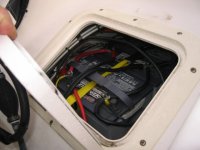Was wondering what some of the other C-Dory boaters are doing to monitor their house batteries. We have two Interstate Deep Charge (class 24? I think) batteries wired in parallel and we make 3-5 day trips. How well can you do watching your voltage level, I'm assuming not accurate enough, as the deep cycles are built to hold their voltage until close to death.
I'm looking at the Link 10 from Xantrex?

You can see more on it at West Marine
http://www.westmarine.com/webapp/wc...attery monitor/All_2/mode+matchallpartial/0/0
Has anyone ever installed one of these? How much trouble is it. I don't want to rewire the entire boat like some of you guys like to do.
So what do some of you folks that make overnight trips (without shore power and generators) do to know where you're at on your battery charge?
John
I'm looking at the Link 10 from Xantrex?

You can see more on it at West Marine
http://www.westmarine.com/webapp/wc...attery monitor/All_2/mode+matchallpartial/0/0
Has anyone ever installed one of these? How much trouble is it. I don't want to rewire the entire boat like some of you guys like to do.
So what do some of you folks that make overnight trips (without shore power and generators) do to know where you're at on your battery charge?
John


